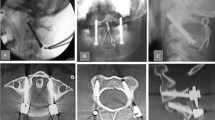Abstract
Background: C1 lateral mass-C2 transpedicular fixation is an accepted surgical procedure of choice in a large number of cases with traumatic atlanto-axial instability. However, bony and vascular anomalies can predispose to unacceptably high risk with this procedure, And hence are the contraindications for this procedure. The purpose of this study is to analyze the clinical and radiological results in such cases for which only unilateral fixation has been performed in cases where bilateral fixation could not be performed due to various reasons.
Materials and Methods: Eight patients (7 males, 1 female) with a mean age of 41.12 years (range 12–68 years), who presented with traumatic atlanto-axial instability and in whom bilateral fixation could not be performed, were treated with unilateral C1 lateral mass-C2 transpedicular fixation. Of these cases, preoperative vertebral artery occlusion was noted in one case, iatrogenic vertebral artery injury in two cases and bony anomalies or fractures in the remaining of five cases. All patients were evaluated clinically with the American Spinal Injury Association (ASIA) scale and radiologically with computed tomography scans and serial X-ray using criteria to evaluate stability.
Results: All cases were evaluated at 6 months followup with mean followup of 2 years and one month (range 6 months to 4 years). All eight patients showed adequate stability and fusion at 6 months; clinically there was no significant restriction of neck movement in any of the patient. There was no neurological deterioration in any of the patient at their last follow-up.
Conclusion: Unilateral C1 lateral mass-C2 transpedicular fixation could be considered a viable option in cases of traumatic atlanto-axial instability where vascular and osseous anomalies contradict a bilateral fixation.
Similar content being viewed by others
References
Goel A, Laheri V. Plate and screw fixation for atlanto-axial subluxation. Acta Neurochir (Wien). 1994;129:47–53.
Goel A, Desai KI, Muzumdar DP. Atlantoaxial fixation using plate and screw method: A report of 160 treated patients. Neurosurgery 2002;51:1351–7.
Harms J, Meicher RP. Posterior C1-C2 fusion with poly axial screw and rod fixation. Spine (Phila Pa 1976) 2001:26;2467–71.
Farey ID, Nadkarai S, Smith N. Modified gallie technique vs trans articular screw fixation in C1-C2 fusion. Clin Orthop Relat Res 1999;359:126–38.
Shetty A, Kini A, Prabhu J. Odontoid fractures - a retrospective analysis of 53 cases. Indian J Orthop 2009;43:352–60.
Madawi AA, Casey AT, Solanki GA, Tuite G, Veres R, Crockard AH. Radiological and anatomical evaluation of the atlanto axial trans articular screw fixation technique. J Neurosurgery 1997:86:961–8.
Miller RM, Ebrahim NA, Xu R, Yeasting RA. Anatomic consideration of transpedicular screw placement in the cervical spine - an analysis of two approaches. Spine (Phila pa 1976) 1996;21:2317–22.
Goel A, Gupta S. Vertebral artery injury with trans articular screw. J Neurosurgery 1999:90;376–7.
Goel A, Kulkarni AG, Sharma P. Reduction of fixed atlanto axial dislocation in 24 cases technical note. J Neurosur Spine 2005;2:505–9.
Paramore CG, Dickman CA, Sontaq VK. The anatomic suitability of C1-2 complex for transarticular screw fixation. J. Neurosurg 1996:85:221–4.
Cought NH, Lanryssen C. Vertebral artery injury in C1-2 trans articualr screw fixation results of a survey of AAMS/CNS sector on disorders of spine anal peripheral nerves. J Neurosurg 1998:86:634–40.
Resnick DK, Lapsiwala S, Trost GR. Anantomic suitability of C1-C2 complex for pedicle screw fixation. Spine (Phila Pa 1976) 2002;27:1494–8.
Abumi K, Itoh H, Taneichi H, Kaneda K. Transpedicular screw fixation for tramatic lesion of middle and lower cervical spine description of techniques and priliminary report. J Spinal Disord 1994;7:19–28.
Mummareni PV, Haid RW. Atlanto axial fixation: overview of all techniques. Neurol India 2005;53:408–15.
Hott JS, Lynch JJ, Chamberlain RH, Sonntag VK, Crawford NR. Biomechanical comparision of C1-2 posterior fixation techniques. J Neurourg Spine 2005;2:175–81.
Cacciola F, Phalke U, Goel A. Vertebral artery in relationship to C1-C2 vertebrae: An anatomical study. Neurol India 2004;52:178–84.
Gupta S, Goel A. Quantitative anatomy of the lateral masses of the atlas and axis vertebrae. Neurology India. 2000;48:120–5.
Paramore G, Dickman CA, Sonntag VK. The anatomical suitability of the C1-2 complex for transarticular screw fixation. J Neurosurg 1996;85:221–4.
Ebraheim NA, Xu R, Ahmad M, Heck B. The quantitative anatomy of the vertebral artery groove of the atlas and its relation to the posterior atlantoaxial approach. Spine (Phila Pa 1976) 1998;23:320–3.
Gorek J, Acaroglu E, Berven S, Yousef A, Puttlitz CM. Constructs incorporating intralaminar C2 screws provide rigid stability for atlantoaxial fixation. Spine (Phila Pa 1976) 2005;30:1513–8.
Lapsiwala SB, Anderson PA, Oza A, Resnick DK. Biomechanical comparison of four C1 to C2 rigid fixative techniques: Anterior transarticular, posterior transarticular, C1 to C2 pedicle, and C1 to C2 intralaminar screws. Neurosurgery 2006;58:516–21.
Dmitriev AE, Lehman RA Jr, Helgeson MD, Sasso RC, Kuhns C, Riew DK. Acute and long-term stability of atlantoaxial fixation methods: A biomechanical comparison of pars, pedicle, and intralaminar fixation in an intact and odontoid fracture model. Spine (Phila Pa 1976) 2009;34:365–70.
Wang MY. C2 crossing laminar screws: cadaveric morphometric analysis. Neurosurgery 2006;59:ONS-84-8.
Chern JJ, Chamoun RB, Whitehead WE, Curry DJ, Luerssen TG, Jea A. Computed tomography morphometric analysis for axial and subaxial translaminar screw placement in the pediatric cervical spine: Clinical article. J Neurosurg Pediatr 2009;3:121–8.
Dorward IG, Wright NM. Seven years of experience with C2 translaminar screw fixation: Clinical series and review of the literature. Neurosurgery 2011;68:1491–9.
Author information
Authors and Affiliations
Corresponding author
Rights and permissions
About this article
Cite this article
Shetty, A., Kini, A., Gupta, A. et al. Management of traumatic atlanto-axial instability: A retrospective study of eight cases. IJOO 46, 86–91 (2012). https://doi.org/10.4103/0019-5413.91641
Published:
Issue Date:
DOI: https://doi.org/10.4103/0019-5413.91641




